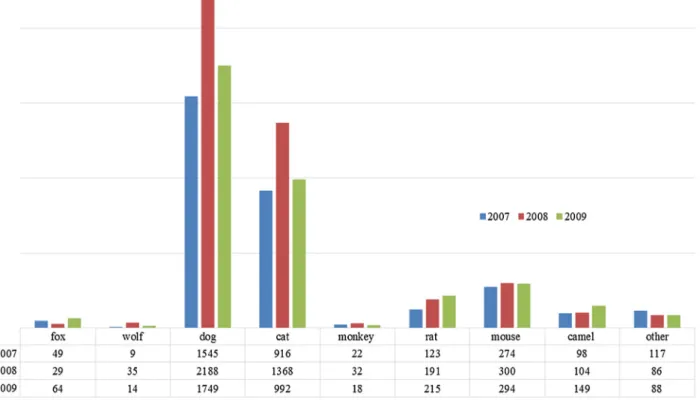HAL Id: hal-01213413
https://hal-amu.archives-ouvertes.fr/hal-01213413
Submitted on 9 Oct 2015
HAL is a multi-disciplinary open access
archive for the deposit and dissemination of
sci-entific research documents, whether they are
pub-lished or not. The documents may come from
teaching and research institutions in France or
abroad, or from public or private research centers.
L’archive ouverte pluridisciplinaire HAL, est
destinée au dépôt et à la diffusion de documents
scientifiques de niveau recherche, publiés ou non,
émanant des établissements d’enseignement et de
recherche français ou étrangers, des laboratoires
publics ou privés.
Rabies in Saudi Arabia: a need for epidemiological data
Ziad A Memish, Abdullah M. Assiri, Philippe Gautret
To cite this version:
Ziad A Memish, Abdullah M. Assiri, Philippe Gautret.
Rabies in Saudi Arabia: a need for
epidemiological data. International Journal of Infectious Diseases, Elsevier, 2015, 34, pp.99-101.
�10.1016/j.ijid.2015.03.016�. �hal-01213413�
Short
Communication
Rabies
in
Saudi
Arabia:
a
need
for
epidemiological
data
Ziad
A.
Memish
a,b,*
,
Abdullah
M.
Assiri
a,
Philippe
Gautret
c,d aSaudiMinistryofHealth,Riyadh,KingdomofSaudiArabiabCollegeofMedicine,AlfaisalUniversity,POBox54146,Riyadh11514,KingdomofSaudiArabia cAixMarseilleUniversite´,URMITE,UM63,CNRS7278,IRD198,Inserm1095,Marseille,France d
InstitutHospitalo-UniversitaireMe´diterrane´eInfection,Marseille,France
1. Introduction
RabiesisendemicinanimalsintheArabianPeninsula,withthe exceptionoftheUnitedArabEmirates,Qatar,andKuwait,which are considered rabies-free.1 No information is available from Bahrain. Certain countries in the area have been reporting increasingnumbersof casesofwildliferabies, includingOman, SaudiArabia,andYemen.2AnimalrabiesinOmanischaracterized bya redfoxsylvaticcycleand casesreportedin camels,cattle, goats,andsheep.3InYemen,themajorityofcasesarereportedin feraldogs.4Rabiesisalsoendemicincountriesborderingthenorth ofthePeninsula:Iraq,inwhichmostcasesarereportedindogsand sporadicallyinwildlife,5andJordan,inwhichcasesarereported mostlyindogsand,toalesserextent,incattle,sheep,andgoats.6 AlthoughSaudiArabiaisthelargestcountryinthePeninsula,little hasbeenpublishedabouttherabiessituationinthecountry. 2. EpidemiologicaldataontherabiessituationinSaudiArabia
Datafromtheyears1986–1992indicatethatmostanimalbites tohumansinSaudiArabiahaveinvolveddogs,cats,rodents,and
foxes,andthatfoxesareanimportantrabiesreservoir.7Accordingto themostrecentdata,itisbelievedthatrabiesisalsotransmitted throughferaldogsinSaudiArabia,butthisisonlypresumptivesince thereareveryfewreportsavailable.8Tothebestofourknowledge, nocaseofhumanrabieshasbeenreportedfromSaudiArabiaover recentdecades.9In2007,asurveywasconductedinQassimregion among4124camels,showinganincidenceof0.2%ofclinicalrabies, likelyresultingfromtransmissionbyferaldogs(70%),followedby foxes(17%).Adiagnosisofrabieswasconfirmedin26dogs,10foxes, eightcamels,andsevencatsinQassimregionbetween1997and 2006.10Atotalof11069animalbitestohumanswerereportedto theSaudiMinistryofAgriculture(MoA)andSaudiMinistryofHealth (MoH)duringtheperiod2007–2009(Figure1).Mostinjurieswere caused by dogs and cats,accounting for 49.5% and 26.6%of all injuries,respectively, followedby mice andrats(12.6%), camels (3.2%),foxes(1.3%),monkeys(0.7%),andwolves(0.5%).
Themonthlyincidenceshowedsomevariationaccordingtothe animal species (Figure 2). Dog and cat bites were frequent throughouttheyear,withatendencytodecreaseinAprilandin August throughOctober.Fox bitesincreasedin Augustthrough September.CamelbitesweremorefrequentinDecemberthrough March. These seasonal variations may reflect Saudi population habits,withpeoplegoingtothedesertforleisureactivitiesduring periodsofgoodweather.Noclearpatternwasobservedforrodent, monkey,andwolfbites.
InternationalJournalofInfectiousDiseases34(2015)99–101
ARTICLE INFO
Articlehistory: Received4March2015
Receivedinrevisedform19March2015 Accepted20March2015
CorrespondingEditor:EskildPetersen, Aarhus,Denmark Keywords: Rabies SaudiArabia Epidemiology SUMMARY
RabiesisendemicinanimalsintheArabianPeninsula.AlthoughSaudiArabiaisthelargestcountryinthe Peninsula,littlehasbeenpublishedabouttherabiessituationinthecountry.Atotalof11069animal bitestohumanswerereportedduring2007–2009,and40animalssuspectedofrabieswereexaminedfor rabiesinfectionfrom2005through2010.Resultssuggestthatanimal-relatedinjuriesinSaudiArabia remainapublichealthproblem,withferaldogsaccountingforthemajorityofbitestohumansandfor themajorityofanimalsfoundtoberabid.Overthelast10years,noconfirmedhumanrabiescasehas beenreported.Moredetailedinformationabouttheepidemiologyofanimalbitesandthatofanimal rabiesinSaudiArabia wouldbe ofgreatinterest,notably toprovideabasisonwhichvaccination recommendationscouldbemadeforthenumerousinternationaltravellersvisitingthecountry. ß2015TheAuthors.PublishedbyElsevierLtdonbehalfofInternationalSocietyforInfectiousDiseases. ThisisanopenaccessarticleundertheCCBY-NC-NDlicense( http://creativecommons.org/licenses/by-nc-nd/4.0/).
* Correspondingauthor.Tel.:+966505483515. E-mailaddress:zmemish@yahoo.com(Z.A.Memish).
ContentslistsavailableatScienceDirect
International
Journal
of
Infectious
Diseases
j o urn a l hom e pa ge : ww w. e l s e v i e r. c om/ l o ca t e / i j i d
http://dx.doi.org/10.1016/j.ijid.2015.03.016
1201-9712/ß2015TheAuthors.PublishedbyElsevierLtdonbehalfofInternationalSocietyforInfectiousDiseases.ThisisanopenaccessarticleundertheCCBY-NC-ND license(http://creativecommons.org/licenses/by-nc-nd/4.0/).
Figure1.NumberofanimalbitestohumansinSaudiArabiaaccordingtotheanimal,fortheyears2007,2008,and2009.
Figure2.NumberofanimalbitestohumansinSaudiArabiaaccordingtothemonth,fortheyears2007,2008,and2009. Z.A.Memishetal./InternationalJournalofInfectiousDiseases34(2015)99–101
Atotalof40 animalssuspectedofrabieswereexaminedfor rabiesinfectionbyhistologicalobservationofNegribodiesinthe brainbetween2005and2010(Table1).Atotalof37werepositive, including11dogs(29.7%),sixfoxes(16.2%),sixsheep(16.2%),five camels(13.6%),fourgoats(10.8%),threewolves(8.1%),andtwo cows(5.4%).
3. Discussion
Rabiesis a reportablediseasein SaudiArabia and theMoH requests that all healthcare facilities in Saudi Arabia report suspected or confirmed human cases to the Public Health DirectoratethroughtheregionalHealthDirectorateineachregion. TheMoAhasassignedthreenationalreferencelaboratoriestothe testingofsuspectedrabidanimalsforrabies;thesearebasedin Qassim,Al-Hassa,andwhenneededJeddah.Apolicyoutliningthe proceduresforsuspectedrabidanimalbrainsamplehandlingand the submission procedure is made available to all healthcare facilitiesbytheMoA.Inaddition,detailedpre-andpost-exposure prophylaxisandtreatmentforrabidanimalhumanbitevictimshas beenoutlinedbytheMoHforallhealthcareprofessionalsinthe KingdomofSaudiArabia.Overthelast10years,noconfirmedcase ofhumanrabieshasbeenreportedbytheSaudiMoH.
Althoughthedatapresentedherearescant,theysuggestthat animal-related injuries in SaudiArabia remain a public health problem,withferaldogsaccountingforthemajorityofbitesto humansandforthemajorityofanimalsfoundtoberabid.More detailedinformationontheepidemiologyofanimalbitesandthat ofanimalrabiesinSaudiArabiawouldbeofgreatinterest.Every yearmorethan10millionpilgrimsfrom184countriesarriveat MakkahfortheHajjortheUmrah,andrabiesvaccineisamongthe preventivevaccinationsthatshouldbeconsideredbefore travel-lingto SaudiArabia.11 The US Centers for Disease Control and Prevention recommend rabies vaccine for specific groups at increasedriskofacquiringrabiesiftheyaretravellingtoSaudi
Arabia.Thesegroupsincludethefollowing:(1)Travellersinvolved inoutdoorandotheractivitiesinremoteareasthatputthematrisk ofanimalbites(suchasadventuretravelandcaving).(2)People whowillbeworkingwithoraroundanimals(suchas veterinar-ians,wildlifeprofessionals,andresearchers).(3) Peoplewhoare takinglongtripsormovingtoremoteareasinSaudiArabia.(4) Children,becausetheytendtoplaywithanimals,mightnotreport bites,andaremorelikelytohaveanimalbitesontheirheadand neck (CDC Travel Guide http://wwwnc.cdc.gov/travel/ destinations/traveler/none/saudi-arabia).
Conflictofinterest:Noconflictofinteresttodeclare. References
1.RupprechtCE,SchlimD.Rabies.CDChealthinformationforinternationaltravel. CDC; 2014.Available at:http://wwwnc.cdc.gov/travel/yellowbook/2014/ chapter-3-infectious-diseases-related-to-travel/rabies(accessed4March2015). 2.WorldHealthOrganization.WHOexpertconsultationonrabies.Secondreport.
WHO;2013.
3.HussainMH,WardMP,BodyM,Al-RawahiA,WadirAA,Al-HabsiS,etal. Spatio-temporalpatternofsylvaticrabiesintheSultanateofOman,2006–2010.Prev VetMed2013;110:281–9.
4.Al-ShamahyAA,SunhopeA,Al-MoyedKA.Prevalence ofrabiesinvarious speciesinYemenandriskfactorscontributingtothespreadofthedisease. SultanQaboosUnivMedJ2013;13:404–10.
5.HortonDL,IsmailMZ,SiryanES,WaliAR,Ab-dullaHE,WiseE,etal.Rabiesin Iraq:trendsinhumancases2001–2010andcharacterisationofanimalrabies strainsfromBaghdad.PLoSNeglTropDis2013;7:e2075.
6.JohnsonN,HannatlehM,Muhaidat A.RabiesinJordan.RabiesBullEurope 2012;36:5–9.
7.WorldHealthOrganization.Reportonthefirstconsultationonwildliferabiesin the Arabian Peninsula. Al-Ain, United Arabian Emirates, 18–19 October 1992. WHO; 1993.Available at:http://whqlibdoc.who.int/emro/-1993/ VPH_13-E_R.pdf(accessed4March2015).
8.WerneryU.ZoonosesintheArabianPeninsula.SaudiMedJ2014;35:1455–62. 9.CarraraP,ParolaP,BrouquiP,GautretP.Importedhumanrabiescases
world-wide,1990–2012.PLoSNeglTropDis2013;7:e2209.
10.Al-DuraibAM.RabiesincamelsatQassimregionofcentralSaudiArabia.JCamel PractRes2007;1:101–3.
11.MemishZA,ZumlaA,AlhakeemRF,AssiriA,TurkestaniA,AlHarbyKD,etal. Hajj:infectiousdiseasesurveillanceandcontrol.Lancet2014;383:2073–82. Table1
RecordedcasesofanimalrabiesinSaudiArabiafrom2005through2010
2005 2007 2008 2009 2010 Suspected cases Confirmed cases Suspected cases Confirmed cases Suspected cases Confirmed cases Suspected cases Confirmed cases Suspected cases Confirmed cases Dog 6 6 1 1 2 2 1 1 1 1 Fox - - 1 1 5 2 3 3 - -Wolf 1 1 1 1 1 1 - - - -Sheep - - 2 2 1 1 2 2 1 1 Goat 1 1 3 3 - - - -Cow - - 1 1 - - 1 1 - -Camel - - 1 1 - - 3 3 1 1 Total 8 8 10 10 9 6 10 10 3 3
